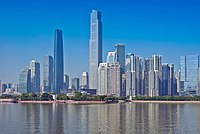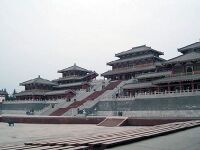Vives-Eaux
Vives-Eaux
春水 Chūn Shuǐ | |
|---|---|
 The Oppidum, the business district of Vives-Eaux | |
| Country | Shang Fa |
| Prefecture | Vives-Eaux |
| District | 24 districcts |
| Government | |
| • Type | Municipality |
| • Body | Boule |
| • Ecclesiaste | Pierre Duroy |
| • Proèdre | Amélie Djèngue |
| Elevation | 5 m (16 ft) |
| Population (2020) | |
| • Total | 3,500,274 |
| Demonym | Aquiprimian |
Vives-Eaux, also known by its Huranian name of Chunshui or by its ancient name of Primevoire d'Aix is the capital city of Shang Fa and its most populated city. Originally a simple fishermen town, the agglomeration' location near the mouth of the Queen River, the largest and longest waterway of Hurania, made it the focus of attention from Auressian, and more importantly Blaykish, traders in the 16th century, quickly developing the town into a trade port and the hub between the Lin Dynasty and Auressia.
After the establishment of the Tan Dynasty and the colonial wars in the Sea of Qes, Chenshui became a de-facto Blaykish and Principean city, with many factories exporting lacquerware, silk, and manufactured products to the rest of the Blaykish Empire, in exchange for spices, luxury goods, and precious metals from the new world.
As such, after the creation of the Great Covenant, Vives-Eaux was naturally chosen as the location of the Megodoquole, the council of representatives from every Principean colony and factory in northern Huran. The Megodoquole would continue to amass power until the Social War (1861 - 1870) which led to the establishment of the Fa Dynasty. Vives-Eaux remained the capital of the new regime, securing its position as the new heart of the region for the centuries to come.
Etymology
Chūnshuǐ is the official romanization of the Huranian name 春水. The name of the city seems to come from the ancient names of two plots of farmlands that were originally turned into the city' first meeting place : the Spring and Autumn Fields. A system of canals and waterways connected this place to the Queen River on the "Spring side" of the plaza, and it's around these waterways that most of the city would end up developing, taking the name of the canal network : "Spring waters".
The city was first known to the Principeans traders as Chounsouhaye as a litteral retranscription of the Huranian name. But as more and more settlers arrived in the trade port, they began translating more directly the Huranian characters and began using Aix-Primevoire-en-Ourane in an official capacity, then shortened into Aix Primevoire or Primevoire d'Aix. But already, in the more popular districts of the city, the habit had settled of calling it Vivedaix or, alternatively, Vives-Eaux. It's finally this second spelling that would win, and the city would be officially renamed to it after Armand Dupic coronation as King Hegemon in an effort to rectify names across the kingdom.
Geography
Vives-Eaux is located near the Estuary of the Queen River, The land is formed by the river's natural deposition and modern land reclamation projects. As such, it has sandy soil, and skyscrapers have to be built with deep concrete piles to avoid sinking into the soft ground.
The city is located on an alluvial plain. As such, the vast majority of its land area is flat, with an average elevation of 5 m. Tidal flat ecosystems exist around the estuary, however, they have long been reclaimed for agricultural purposes. Vives-Eaux's few hills lie directly to its south with its highest peak, the Colline-à-Charbon, separate the old core of the city from the Hegemon Palatial Complex.
History
Politics
Administrative divisions
Vives-Eaux is divided into 24 Districts (區; Qū) and while each has its own urban core, the city hall and major administrative units are located either in Primeverre-et-Gain (Town) (春秋區; chūn qiū qū), which also serves as a commercial area, or in Auguste (皇區; Huáng qū) which is centered around the Hegemon palatial complex, the Palace of Rebirth.
Structure
Each district' administration is headed by a Partodane, with law enforcement in the hands of a Subellaune and local judiciary led by a Dicaste. Each are delegates appointed by their respective superiors at the city' level : the Arioparte for the administration, the Vellaune for the police, and the Bretodane for the judiciary. Both the Arioparte and the Vellaune are themselves under the leadership of the Ecclesiaste, whom is helped in the day-to-day handling of the city by the Boule, presided by the Proèdre.
The Ecclesiaste of Vives-Eaux is elected indirectly by the city's voters. The voters of each of the 24 Districts instead elect members to the Boule which subsequently elects the mayor. The allocated numbers of seats to a district depends on its population, with an average of 5 seats per District for a total of 121 seats. Elections are done under the principles of a Closed list Proportional representation single-round system. Seats are distributed to all lists which won at least 5% of the votes using the Highest averages method.
Judiciary and procuracy

In each district there is a Microbrete. In these courts of first instance, proceedings are conducted based on oral testimony and arguments, and, unlike in higher courts, legal counsel is not mandatory. But its rulings may be appealed to Vives-Eaux ' appelate court, the Rebrete. The Rebrete is located in the Outer Southern Wing of the Palace of Rebirth, in the Auguste District, which is also the royal residence and the location of Shang Fa Supreme Court (in the Inner Northern Wing).
The most infamous prison of Vives-Eaux remain the Petite-Porte which became a location of ill-repute as the place where political opponents in the early days of the Fa Dynasty and later during the Pingyou Decade were sent to disappear. Nowadays, there is only two remaining penitentiary in Vives-Eaux : the remand center of Bonne-Saison and the jails of the Palace of Rebirth itself. The latter sole purpose is to hold convicted prisoners awaiting a retrial, making Bonne-Saison to sole permanent penitentiary of the city. The other prisons associated with Vives-Eaux are nowadays located far outside the city's limits.
Police force
The security of the city is mainly the responsibility of the Police Commandery of Vives-Eaux, a subdivision of the Security Ministry. It supervises the units of the Dynastic Police who patrol the city and the three neighbouring prefectures. It is also responsible for providing emergency services, including firefighters. Its headquarter is still officially located in the old Place d'Automne, although most of its administration has been relocated to Tour-Reine new police center, which finished construction in 2015. There are currently 30,000 police officers under the city's Vellaune command.
Beside the police, both the Maréchaussée and the Justice Guards have a strong presence in Vives-Eaux. The former are mostly represented by their special branch of the Bayares, which provides guards of honour and actual security for both the executive and the legislative in Vives-Eaux. Meanwhile, the latter, nicknamed the Feather Forest, is a para-military unit under direct royal command and also tasked with providing an honor guard and actual security, but for the legislative branch of the government. It is also tasked with enforcing court decisions and supervising the country's prisons. The First, Third, and Fifteen Regiments are the Justice Guard' units affected to Vives-Eaux Prefecture.
Economy
Vives-Eaux is the national center for finance, commerce, trade, and transportation with the country's busiest container port. The city has a post-industrial economy that is dominated by the tertiary sector (services), which generated 87.9% of output, followed by the secondary sector (manufacturing, construction) at 11.3% and the primary sector (agriculture, mining) at 0.7%. In total, Vives-Eaux' economic output represent 22% of Shang Fa' total GDP. It's six largest industries —retail, finance, IT, real estate, machine manufacturing, and automotive manufacturing— comprise about half the city's GDP.
the average annual disposable income of Shang Fa' residents was the national highest, making it the wealthiest cities in Shang Fa, but also the most expensive city to live in.
Transportation
Demographics
As of 2020 Vives-Eaux had a population of 3,500,274 registered inhabitants. Based on the population of its total administrative area, Vives-Eaux is the largest municipality of Shang Fa. A position only reinforced by taking into account its total metropolitan area, which include between 412 to 1,794 communes for around 11 to 14 million people, slightly more than a ninth of the total population of the Dynasty.
As per the law, census in Shang Fa do not ask any ethnic or religious question. However, they do collect data about places of birth and origin, which makes it possible to assert that Vives-Eaux is the main destination of domestic immigration in Shang Fa. Around half of the city's residents were born in other regions of the country.
People born in foreign countries without the Legal Citizenship at birth are counted in official census as migrants. According to the Vives-Eaux' statistic bureau, about 317,900 residents within the 24 Districts and 1,240,134 in the greater urban area. 21,900 immigrants were from Amandine, 28,900 from Selajung, 67,078 from Northern Auressia.
Religion
Due to its cosmopolitan history, Vives-Eaux has a blend of religious heritage; religious buildings and institutions are scattered around the city. In census, only people belonging to an organized religion, meaning members of its clergy, are counted as being of that religion. This was one of the many reforms introduced in the 1950s - 1960s decades to better reflect the census to the habits of Shang Fa' population. In this case, to match the fact that most of the country' citizens can be involved in one or multiple religions while also worshipping nature deities or respecting traditional ancestor veneration.
Around 10% of Vives-Eaux metropolitan population is at the very least initiated to a Perendist institution and can be expected to partake solely in religious activities related to the "Religion of the Earth" (地教; dìjiào). Macakkanism, both of the old and new law, represent another 20% of the population. Finally, a number of Neo-Macakkanists, salvationists cults compete for followers, but the largest of these "new schools" remain the Redempting Path (道救贖; Dào Jiùshú) or Jiuism (救教;jiùiào) with 5% of the population proclaiming its adherence to the sect.
While New Law Macakkanism was present, and even dominant, in the region of Vives-Eaux since the days of the Alawokambese hegemony, urban development only really took off after the foundation of a Mission by Nicolas Bertrand D'Arixomage, the Omphalonémète, which still exist to this day, and the concession of the city as free port to the Blaykish Empire. Apostolic Perendism then became the dominant religion of the new city, a position that was only contested after two centuries of rural exodus which brought new populations within the city, and with them their own religious practices and cults.
Jiuism grew in Shang Fa in the decades preceding the Social War and has known a period of popularity in Vives-Eaux at the turning of the previous century, especially among the city's elites. With half a million of adherents, it remain the city's largest "cult", and has a far reaching influence through its members' own networks or through those who are interested in the Redempting Path, participating in its ceremonies and festivities, without joining officially the organisation.
Culture
Cuisine
Due to Vives-Eaux cosmopolitan nature, many styles cohabit and mix together in Vives-Eaux restaurants, with inspirations from all over Surucia, Auressia, and Marceaunia. There's an heavy focus on seafood and dumplings, consumed by every social classes of the city. Beside fishes and molluscs, the most popular meats are mutton and beef.



